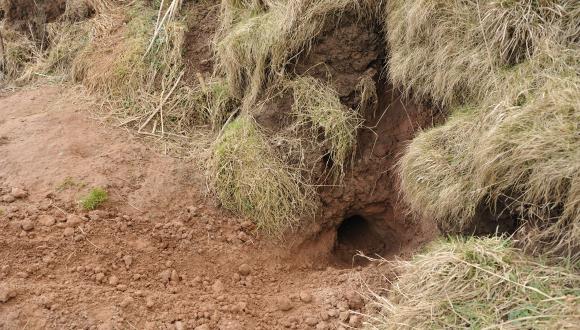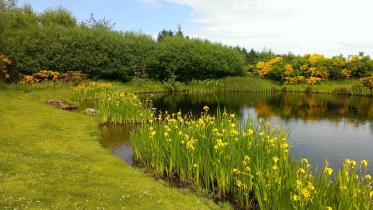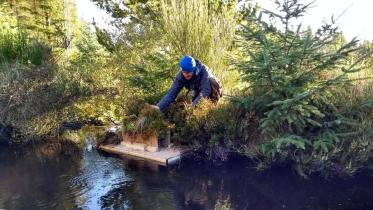Standing advice for planning consultations - Badgers
This is standing advice to help planning applicants seeking permission for development that could affect badgers, and to assist planning officers and other regulators in their assessment of these applications. It avoids the need for us to advise on individual planning consultations in relation to badgers. We will only provide further advice in exceptional circumstances that are not covered by this standing advice.
Consideration of protected species in development management
Scottish Planning Policy requires that the presence (or potential presence) of legally protected species is factored into the planning and design of development proposals, and that any impacts on protected species are fully considered prior to the determination of planning applications.
Where impacts on a protected species cannot be avoided, certain activities may only be undertaken with a licence from NatureScot. It is important that any licensing issues are considered as part of a planning application to avoid any unnecessary delay to a development proceeding.
Legal protection for badgers
Badgers and their setts are protected by the Protection of Badgers Act 1992. Offences relevant to development works include:
- wilfully injuring or killing a badger;
- disturbing a badger while it is in a sett;
- intentionally or recklessly damaging or destroying any part of a badger sett, or obstructing access to a sett.
The Protection of Badgers Act defines a badger sett as 'any structure or place which displays signs indicating current use by a badger'. To help you make an assessment of what might or might not constitute a badger sett see Licensing Guidance: What is a badger sett?.
This means that if badgers could be affected in these ways by a development, and no action is taken to prevent it, an offence may be committed. The advice below will help ensure that impacts on badgers are minimised and no offences occur.
When a development could affect badgers
Badgers are found throughout most of mainland Scotland in both urban and rural areas, particularly in the lower lying, more fertile parts of the country. For an up to date map of badger distribution see the National Biodiversity Network Atlas. The NBN Atlas map indicates the broad pattern of distribution across Scotland but cannot provide detailed information for individual development sites. Local Record Centres may have additional information that can help determine if badgers are likely to be present. See also the Atlas of the Mammals of Great Britain & Northern Ireland (The Mammal Society/Pelagic Publishing 2020). Development within the Inverness area should take account of The Highland Council’s Badger Policy Guidance Note, which can be regarded as a best practice model for applying elsewhere in Scotland, wherever possible
Favoured sites for badger setts are where there is dry, sandy soil that is easy to dig. Setts are often located in woodland, hedgerows or in dense patches of scrub on steep banks close to fields. However, setts can also be found in open fields, as well as railway embankments, old quarries, rock cavities and landfill sites.
A badger survey should be carried out where there is potentially suitable habitat within or close to a development site. As a guide, any work within 30m of an entrance to a badger sett (or 100m for pile driving and blasting work) could result in disturbance of a badger in the sett, or block or damage tunnels that radiate from the entrance to the sett.
Carrying out a badger survey
Surveys should be done by persons with the appropriate knowledge of badger ecology and practical experience of badger survey work. A badger survey can be carried out at any time of year but the optimum time is February to April. It involves the systematic search of suitable habitat for signs of badgers, such as footprints, hair, snuffle holes, latrines and sett entrances.
Where a development proposal could impact one or more social groups of badgers, and the presence of neighbouring social groups is likely to restrict how the impacted badgers can respond (e.g. by adjusting territory boundaries), ‘bait marking’ will be required. This is a method used to determine group territories and how the site is being used by different social groups. This technique is labour-intensive and requires specialist knowledge and experience. It involves using small harmless, coloured beads in food put out for badgers. These beads can then be found in latrines and dung-pits that the badgers use to demarcate the boundaries of their territory. This allows the mapping of territories, which can inform a mitigation plan to address the foraging requirements of the affected social group(s).
The survey information needs to be sufficiently up-to-date when a planning application is submitted. Pre-application badger surveys normally remain valid for two years, and should be repeated if the application is delayed beyond that. Unless it is clearly evident that there has been no substantive change in number, distribution or activity of badgers since the original survey was undertaken.
For further advice on badger surveys see Surveying for Badgers Good Practice Guidelines by Scottish Badgers. NatureScot endorses the survey techniques detailed in this document, including the recommended 100m survey buffer around the boundary of proposed developments.
Reporting survey results
If a development proposal has needed a badger survey, a survey report must be submitted as part of the planning application. The report should include:
- names and experience of surveyors;
- details of any information gathered from Local Record Centres or other sources;
- descriptions of habitat surveyed and any limitations to the survey, such as access;
- survey methods, including survey area, date, time and weather conditions;
- a map showing badger habitat and the location of sett entrances, badger signs, well-used pathways and group territories in relation to the development;
- an assessment of how the development might affect badgers.
If badgers could be affected by the proposal, the report must include a protection plan. The plan should include:
- measures proposed to minimise impacts on badgers, including annotated maps and/or photographs showing the location of any measures proposed and how they relate to survey information and construction work;
- a summary of any residual impacts once the above measures are taken into account;
- details of any licensing requirements.
For further advice see our Badger Protection Plan Guidance Note. Please note however that a 1km search area/buffer distance around the development boundary is recommended in this guidance note. This is because the document is tied closely to the Inverness Badger Strategy for which the necessary wider survey information was required. We recognise that a 1km survey buffer is unlikely to be necessary or practical in all but the largest developments, and therefore the 100m buffer outlined in the Surveying for Badgers Good Practice Guidelines is acceptable in most cases. If in doubt contact the NatureScot licensing team for advice.
Measures to minimise impacts on badgers
Measures to minimise impacts on badgers should follow a hierarchy of avoidance, mitigation and compensation:
Avoidance
- Design the development and construction methods to avoid damage or disturbance to setts and to avoid disturbance of badgers once the development is operational; a buffer zone of undeveloped land can help minimise future conflicts once a development is complete, and it is important to safeguard key sources of water for badgers.
- Avoid the use of noisy plant and machinery in the two hours before sunset within the vicinity of a sett.
Mitigation
- Mark exclusion zones around setts; the boundary of the exclusion zones should be a minimum of 30m from sett entrances (100m for pile driving or blasting work). Where exclusion zones of the required size aren’t possible, works will require a licence from NatureScot before they can proceed.
- Cap exposed pipe systems when contractors are off site, and cover or provide exit ramps from exposed trenches or holes, to prevent badgers becoming trapped.
- Fell trees away from badger setts and avoid blocking any badger pathways.
- Direct any security lighting away from setts.
- Store chemicals in a safe place.
- Plant dense native shrubs around setts to provide added protection (eg. gorse, blackthorn, holly and elder).
- Install underpasses and fencing to enable badgers to cross busy roads safely.
Compensation
- Enhance foraging habitat to offset any significant loss of feeding areas; see Managing Land as a Foraging Resource for Badgers.
For all development proposals where badgers are a consideration, pre-construction surveys should be timetabled into project plans. This is to enable checks for any new setts that may have become occupied after the original survey, and to ensure the measures proposed to minimise impacts on badgers remain appropriate. Pre-construction surveys should be completed as close to the construction period as possible, and no more than 3 months before the start of works.
Licensing development works affecting badgers
If a development cannot avoid damage or disturbance of a badger sett, a licence will be required from NatureScot to allow work to proceed. If applying for a licence, refer to our Guidance Notes for Providing Supporting Information for Badger Licence Applications.
Every effort should be made to retain setts on the site. However, if the destruction of a sett is unavoidable, a licence would allow this. Under the licence, the badgers would first need to be safely excluded from the sett using a combination of fencing and/or specially designed one-way gates that allow the badgers out of the sett area, but prevent their re-entry.
Licences are not normally granted for works during the badger breeding season (1 December to 30 June) when they are most sensitive to disturbance. At other times of the year, a licence will only be issued if there are alternative setts available for badgers to move to within the same territory. If there are no other suitable setts available, an artificial sett must be provided, but this must be seen as the least preferred option. The site for an artificial sett must be carefully selected and all work supervised by a badger expert. The most successful artificial setts have been located less than 100m from the original natural sett and constructed at least six months before the badgers are excluded. For further details see Guidance for the Creation of Artificial Setts (but note that the cost information in this document is out of date).
For advice on whether or not a licence is likely to be granted, planning applicants and planning officers may contact the NatureScot licensing team. An up-to-date badger survey and a badger protection plan for the proposed development must be submitted with the enquiry, together with details of the development proposals. We would normally only expect these enquiries when proposals are of such a scale that they may lead to displacement of a badger social group from its territory.
For further information on protected species licensing see Protected Species Licensing: Legislation, Appropriate Authorities and Licensing Purposes, and further information and advice on various aspects above can be found in our publication Badgers and Development available from National Library of Scotland. This publication was written in 2001 and is out of date in parts, but the advice on fences, badger gates, and artificial setts is still applicable.
Contact
If you already have a licence number, include it in the subject line of your email, or have it to hand when you call.






